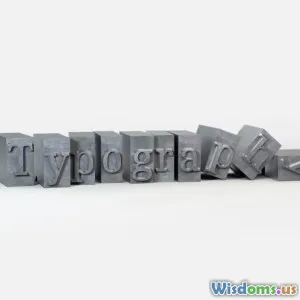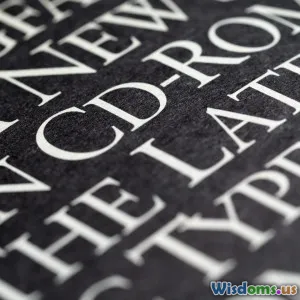
Debunking Typography Myths Every Designer Should Forget
8 min read Explore and debunk common typography myths that hinder design creativity and effectiveness. (0 Reviews)
Debunking Typography Myths Every Designer Should Forget
Typography is the silent ambassador of your brand and message. Yet, despite its crucial role, myths and misconceptions around typography persist, often limiting designers’ creativity and effectiveness. These myths are passed down like folklore, accepted without question, and ironically, they restrict the versatile art and science of type.
This article dives into the most common typography myths, dismantling them with facts, expert insights, and practical examples. Whether you're a seasoned designer, freelancer, or just starting out, shedding these falsehoods will elevate your work and deepen your appreciation for typography.
Myth 1: Serif Fonts Are Only for Print, Sans-Serif Only for Screen
A long-held belief is that serif fonts—those with small strokes at the ends of letters—are only appropriate for print materials, while sans-serifs are the digital domain. This led to blanket decisions where designers avoided serifs online, stifling design variety.
The Reality:
Recent research and technology trends show this boundary is artificial. With modern screen resolutions (think Retina or 4K displays), serifs render beautifully and improve readability. For example, Georgia, a popular serif font, was specifically designed for screen legibility by Microsoft and has since proved successful across digital platforms.
Expert Insight: Typography scholar Matthew Carter noted: "Designing Georgia was proof that serifs can be clear and inviting on digital devices, arguing against the myth that they’re unsuitable for screens."
Real-World Example:
The New York Times digital edition employs a serif font for body text, embracing a traditional yet elegant feel on screens. This approach reinforces trust and readability.
Key takeaway: Designers should prioritize legibility, brand personality, and context over outdated genre-based font rules.
Myth 2: Using More Fonts Makes Your Design Look Better
It's tempting to add numerous font styles to create impact or variety, but this almost always backfires.
The Reality:
Too many fonts create visual chaos and distract users, diluting brand cohesion and hampering user experience. Studies show that designs with more than two or three font families become confusing and harder to process.
Evidence-based Rationale:
The well-known design maxim is: limit your fonts. Renowned typographer Jessica Hische advocates for 2–3 font varieties to maintain a clear hierarchy and aesthetic harmony.
Practical Application:
Look at Apple’s branding: it predominantly uses just one or two font families across products, ads, and web.
Tip: Utilize font weights, sizes, and styles (bold, italic) within a font family to craft hierarchy rather than switching to different fonts.
Myth 3: All Caps Means Emphasis or Shouting
There’s a strong association of ALL CAPS with shouting or aggression in digital communication. Designers sometimes avoid using all caps fearing it alienates readers.
The Reality:
While ALL CAPS can feel loud in casual contexts, when used thoughtfully in design, it offers clarity, structure, and elegance. For instance, ALL CAPS are effective in titles, headers, and signage for quick recognition.
Insight from Experts: Erik Spiekermann, a typographic legend, notes that ALL CAPS create a uniform line height which aids in certain display uses.
Case Study:
Luxury brands (like Chanel or Vogue) use all caps in logos and headlines to project authority and sophistication.
Guideline: Consider font choice, letter spacing, and context to ensure all caps communicate the intended tone rather than shouting.
Myth 4: Kerning and Tracking Are Minor Details Designers Can Skip
Due to their finicky nature, kerning (adjusting space between individual letter pairs) and tracking (spacing between groups of letters) sometimes get overlooked.
The Reality:
Kerning and tracking dramatically influence readability and aesthetic appeal. Poor kerning can cause distracting gaps or letter collisions, undermining the professionalism of a design.
Fact: Typography experts emphasize that subtle kerning adjustments can be the difference between an amateurish and polished look.
Example:
Notice the difference between "A V" in default spacing versus carefully kerned—the visually awkward white space becomes harmonious, aiding fluid reading.
Conclusion: Don’t skimp on these details; they reflect craftsmanship.
Myth 5: Typeface Choice Doesn’t Affect Brand Perception
Some designers treat font selection as an afterthought, assuming content alone carries the brand presence.
The Reality:
Fonts are powerful conveyors of personality, tone, and values. Brands leverage typefaces to shape perceptions consciously.
Supporting Data:
A study by the Software Usability Research Laboratory revealed font choices impact how trustworthy, competent, and likable brands appear. For instance, sans-serifs often feel modern and approachable, while serifs evoke tradition and reliability.
Real brand example:
Coca-Cola’s script font is iconic and conveys friendliness and authenticity.
Advice: Treat typography as integral to brand strategy, not mere decoration.
Myth 6: Good Typography Is Achieved With Rules, Not Experimentation
Many believe typography only works within strict rules about spacing, line length, or font pairing.
The Reality:
While guidelines ensure baseline effectiveness, groundbreaking designs thrive on experimentation and breaking conventions.
Pioneers such as Paula Scher demonstrate how unconventional typographic treatment can generate innovation and emotional resonance.
Example:
Web and app interfaces increasingly employ motion typography, variable fonts, and responsive sizing, adapting to context dynamically.
Final note: Rules are foundations, not limitations. Mastery involves knowing when and how to creatively break them.
Conclusion
Typography is deeply nuanced—a blend of historical legacy, cognitive science, and creative expression. Myths persist because typography can seem intimidating and subtle, but shedding these dated beliefs shakes design out of stagnation.
Designers should embrace evidence-based practices, re-examine assumptions, and balance rules with creativity. As you experiment, remember: effective typography ultimately connects, informs, and delights your audience.
Ditch the myths, hone your craft, and let your type tell the real story!
Author’s note: To improve your typography skills further, consider exploring type anatomy, x-height effects, and the psychology of colors paired with fonts. Remember, the best design serves people, not rules.
Rate the Post
User Reviews
Popular Posts

















